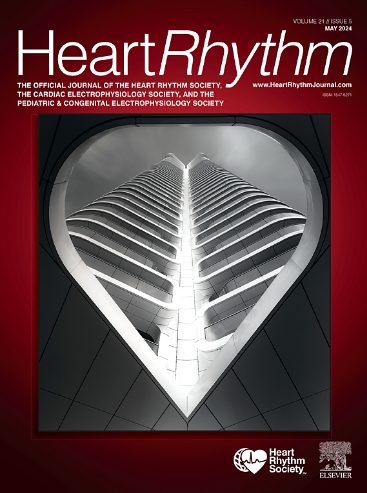创伤性脑损伤与随后发生心房颤动或心房扑动的风险有关。
IF 5.6
2区 医学
Q1 CARDIAC & CARDIOVASCULAR SYSTEMS
引用次数: 0
摘要
背景:创伤性脑损伤(TBI)与多种长期不良后果有关,并会增加交感神经系统的激活,从而增加心律失常(包括心房颤动或心房扑动(AF/AFL))的风险:目的:在一大批 9/11 事件后的军人和退伍军人中研究创伤性脑损伤发作和随后的房颤/心房扑动:研究变量为创伤性脑损伤,按严重程度(轻度、中度/重度和穿透性)进行分层。结果是随后被诊断为房颤/急性心力衰竭。我们使用 Fine-Gray 竞争风险模型来评估创伤性脑损伤对后续房颤/急性心力衰竭的潜在风险:在纳入分析的 1,924,900 名受试者中,369,891 人(19.2%)经历过有据可查的创伤性脑损伤。大多数人是年轻人(63%不到35岁)、男性(81.7%)和非西班牙裔白人(62.7%)。22,087 名受试者被诊断为房颤/自发性心力衰竭。在单变量分析中,只有穿透性创伤性脑损伤(危险比 [HR] 2.02,95% 置信区间 [CI] 1.84-2.23;p 结论:我们发现,创伤性脑损伤,尤其是穿透性创伤性脑损伤,会显著增加房颤/自发性心力衰竭的风险。还需要进一步研究以确定创伤性脑损伤后心律失常的长期风险。本文章由计算机程序翻译,如有差异,请以英文原文为准。
Traumatic brain injury is associated with the subsequent risk of atrial fibrillation or atrial flutter
Background
Traumatic brain injury (TBI) is associated with a variety of adverse long-term outcomes and increases sympathetic nervous system activation, which could increase the risk of arrhythmias including atrial fibrillation or atrial flutter (AF/AFL).
Objective
We examined episodes of TBI and subsequent AF/AFL in a large cohort of post-9/11 servicemembers and veterans.
Methods
The variable of interest was TBI, stratified by severity (mild, moderate/severe, and penetrating). The outcome was a subsequent diagnosis of AF/AFL. We used Fine-Gray competing risks models to evaluate the potential risk imparted by TBI on subsequent AF/AFL.
Results
Of the 1,924,900 participants included in the analysis, 369,891 (19.2%) experienced an episode of documented TBI. Most were young (63% <35 years), male (81.7%), and non-Hispanic White (62.7%). AF/AFL was diagnosed in 22,087 patients. On univariate analysis, only penetrating TBI (hazard ratio [HR], 2.02; 95% confidence interval [CI], 1.84–2.23; P < .001) was associated with AF/AFL compared with veterans without TBI. After adjustment in the full multivariable model (adjusted for age, sex, race and ethnicity, service branch, rank, component, and comorbidities), mild (HR 1.27, 95% CI 1.22–1.32; P < .001), moderate/severe (HR, 1.34; 95% CI, 1.24–1.44; P < .001), and penetrating TBI (HR, 1.82; 95% CI, 1.65–2.02; P < .001) were significantly associated with AF/AFL compared with no TBI. Post hoc analyses demonstrated that the risk of AF/AFL was concentrated in female and younger patients.
Conclusion
We found that an episode of TBI, particularly penetrating TBI, significantly increased the risk for AF/AFL. Further work is needed to delineate the long-term risk of arrhythmias after TBI.
求助全文
通过发布文献求助,成功后即可免费获取论文全文。
去求助
来源期刊

Heart rhythm
医学-心血管系统
CiteScore
10.50
自引率
5.50%
发文量
1465
审稿时长
24 days
期刊介绍:
HeartRhythm, the official Journal of the Heart Rhythm Society and the Cardiac Electrophysiology Society, is a unique journal for fundamental discovery and clinical applicability.
HeartRhythm integrates the entire cardiac electrophysiology (EP) community from basic and clinical academic researchers, private practitioners, engineers, allied professionals, industry, and trainees, all of whom are vital and interdependent members of our EP community.
The Heart Rhythm Society is the international leader in science, education, and advocacy for cardiac arrhythmia professionals and patients, and the primary information resource on heart rhythm disorders. Its mission is to improve the care of patients by promoting research, education, and optimal health care policies and standards.
 求助内容:
求助内容: 应助结果提醒方式:
应助结果提醒方式:


